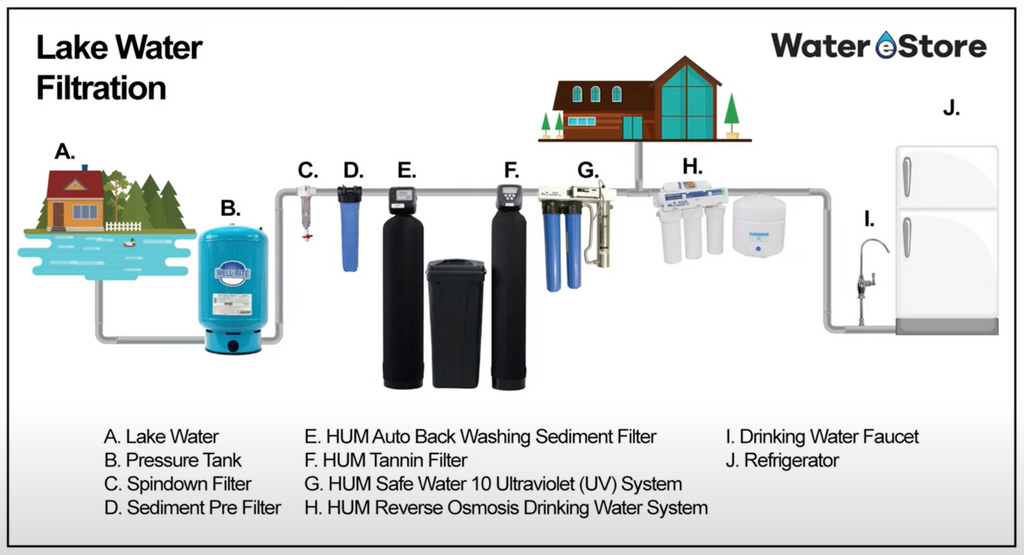
Is your lake water giving you grief? Are you unhappy with the safety, taste, smell, discolouration or staining caused by your lake water and need to know how and where to start to fix it?
You’ve likely heard of Tannin filters, UV systems and even ROs, but what do all of these things do, where are they installed and in what order do they go? Do you really need all of these for your family?
If you’re a home, cottage or cabin owner that’s unhappy with their lake water but feeling confused as to what you need to do to get it fixed, this article is for you. Today I’m going to explain what you need to get the best well water filtration system for your family starting right now!
By the end of this article, you’ll know what a complete lake water filtration system consists of, what each component is called and what it does — as well as the correct order of the equipment. I’ll also detail what next steps you should take to get your water fixed.
Follow along as I take you through our Lake Water Infographic and I explain each phase of filtration, what it does, and why — or IF — you need it for your family.
LET'S GET STARTED...
Basically, we need to clean up the water to remove the dirt, color and impurities so your water won’t stain your fixtures and then we disinfect it so it’s safe for your family. Let’s check it out step by step!
First of all, it's important to know that depending on your water quality, you won’t need every piece of equipment discussed here but it helps to know what each one can do for your family.
STEP 1: THE PRESSURE TANK
Water starts from your well and flows through your pressure tank. The pressure tank accumulates water, under pressure, and pushes out your water to your household under pressure when needed. The pressure tank makes your pump last longer because the pump doesn’t need to turn off and on for every small amount of water you use.
STEP 2: WATER PRE-FILTRATION

You would use one or more of these sediment prefiltration systems depending on how much dirt is in your water and how much water you use. If there is virtually no dirt then you don’t need any of them.
A Spindown filter is used for very coarse filtration. These use centrifugal force when the tap at the bottom is opened to flush out the debris. You would need to manually open the valve at the bottom periodically, usually once a week or more often if a lot of dirt is present, as they aren’t an automatic system.

Filter housings with a coarse sediment filter do the pre-filtering. If the dirt amount isn’t too bad, you could use one of these to pre-filter your water before any water filtration equipment (like an iron filter or water softener) in order to protect the equipment by keeping the dirt out. The filter element will need to be changed at least once a year or more frequently if they become clogged.

Our HUM Automatic backwashing sediment filter is used when you have so much dirt in your water that you’re constantly replacing sediment filters. These are great because the dirt accumulates inside while you’re using your water and then every 4 days or so they backwash to flush out all of the debris automatically. Makes life easier for you, no filters to change and no chemicals involved!

If you’re experiencing brown water caused by tannins, this is where the tannin filter goes. As water passes through it removes the color caused by organics. The tannins are the result of decomposing organics like cedar roots tinting the water. Tannin filters use water softener salt to clean up the media. These clean or regenerate the media every 3 days so you will need to add water softener salt periodically.
STEP 3: WATER DISINFECTION

By now, we’ve cleaned up the water and removed anything that would stain any surfaces, so we need to disinfect your water to make sure that it is safe and bacteria-free for your family. For this, we need an Ultraviolet Disinfection system, also known as UV. Water flows through the UV and, together with the fine pre-filters like in this HUM Safe Water 10 UV, disinfects your water, killing any bacteria and making it safe to drink for your family.
STEP 4: EXCESS MINERAL REMOVAL

To remove minerals from your water and create a second barrier from bacteria you would add a Reverse Osmosis drinking water system. This is not a whole house system, it is location specific. Once you have an RO system installed (like the HUM Water Saver 75), super pure reverse osmosis water will be dispensed from a separate faucet at the kitchen sink and connected to your fridge if you have a water or ice dispenser in your fridge.
Putting it all together we have this helpful infographic.

NEED A PERSONALIZED RECOMMENDATION?
So what do you need in a lake water filtration for your family? We would be happy to make a recommendation, but we need to know some information before we can help you.
For proper water analysis, we need to know your water chemistry; in other words, how high the level of tannins in your water is and a few other parameters.
If you don’t have a lab report done yet, Water eStore offers FREE Testing!
Simply mail us a water sample for free testing to:
Water Store, 1004 King Street, Midland, Ontario L4R 0B8
Once you have your water chemistry, download this form to fill out, then scan or take a picture with your phone and email it back to us with your water chemistry information. From there, we’ll put together a personalized lake water filtration system recommendation for your family!

